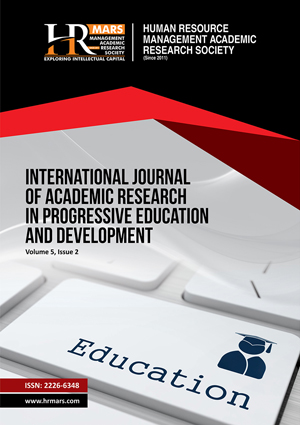
ISSN: 2226-6348
Open access
Since the 1990s, chemists' interest in green chemistry has been increasing annually, accompanied by a growing number of research reports on green or clean chemistry in both academia and industry. There is an increasing realization that science and technology alone are insufficient to manage chemical waste and hazardous substances effectively, thereby protecting human health and the environment. Consequently, the development and promotion of green chemistry are imperative. Education plays a unique and crucial role in disseminating the principles of green chemistry. This study focuses on publications related to green chemistry education from 2014 to 2024. It employs a combination of systematic literature review (SLR) and bibliometric analysis (BR) methodologies, following the 2020 PRISMA statement template. By screening 512 relevant publications from the Web of Science database, this paper identifies the most influential journals and authors in the field of green chemistry education and analyzes the countries that have made the most significant contributions to this research area. Furthermore, the paper provides a detailed review and analysis of key research keywords and significant subject areas. These findings offer valuable insights into understanding research trends in green chemistry education. By examining critical areas such as journals, authors, countries, and keywords, this study aims to provide an overview of current research trends and valuable insights for future research and practical applications. Ultimately, the goal is to improve the existing chemistry education system and enhance public awareness of sustainable development and environmental protection concepts.
Andraos, J., & Dicks, A. P. (2012). Green chemistry teaching in higher education: a review of effective practices. Chemistry Education Research and Practice, 13(2), 69-79.
Armstrong, L. B., Rivas, M. C., Douskey, M. C., & Baranger, A. M. (2018). Teaching students the complexity of green chemistry and assessing growth in attitudes and understanding. Current Opinion in Green and Sustainable Chemistry, 13, 61-67. https://doi.org/10.1016/j.cogsc.2018.04.003
Avsec, S., & Jagie??o-Kowalczyk, M. (2021). Investigating Possibilities of Developing Self-Directed Learning in Architecture Students Using Design Thinking. Sustainability, 13(8). https://doi.org/10.3390/su13084369
Brun, M. (2021). What is Green Chemistry? Journal of Chemical Reactivity and Synthesis, 11(1), 33-40.
Falagas, M. E., Pitsouni, E. I., Malietzis, G. A., & Pappas, G. (2008). Comparison of PubMed, Scopus, web of science, and Google scholar: strengths and weaknesses. The FASEB journal, 22(2), 338-342.
Ferk Savec, V., & Mlinarec, K. (2021). Experimental Work in Science Education from Green Chemistry Perspectives: A Systematic Literature Review Using PRISMA. Sustainability, 13(23). https://doi.org/10.3390/su132312977
Gawlik-Kobylin?ska, M., Walkowiak, W., & Maciejewski, P. (2020). Improvement of a sustainable world through the application of innovative didactic tools in green chemistry teaching: A review. Journal of Chemical Education, 97(4), 916-924.
Kurowska-Susdorf, A., Zwier?d?y?ski, M., Bevanda, A. M., Tali?, S., Ivankovi?, A., & P?otka-Wasylka, J. (2019). Green analytical chemistry: Social dimension and teaching. TrAC Trends in Analytical Chemistry, 111, 185-196. https://doi.org/10.1016/j.trac.2018.10.022
Lokteva, E. (2018). How to motivate students to use green chemistry approaches in everyday research work: Lomonosov Moscow State University, Russia. Current Opinion in Green and Sustainable Chemistry, 13, 81-85. https://doi.org/10.1016/j.cogsc.2018.04.021
Marteel-Parrish, A., & Newcity, K. M. (2017). Highlights of the Impacts of Green and Sustainable Chemistry on Industry, Academia and Society in the USA. Johnson Matthey Technology Review, 61(3), 207-221. https://doi.org/10.1595/205651317x695776
Meho, L. I., & Yang, K. (2007). Impact of data sources on citation counts and rankings of LIS faculty: Web of Science versus Scopus and Google Scholar. Journal of the american society for information science and technology, 58(13), 2105-2125.
Page, M. J., McKenzie, J. E., Bossuyt, P. M., Boutron, I., Hoffmann, T. C., Mulrow, C. D., Shamseer, L., Tetzlaff, J. M., Akl, E. A., Brennan, S. E., Chou, R., Glanville, J., Grimshaw, J. M., Hrobjartsson, A., Lalu, M. M., Li, T., Loder, E. W., Mayo-Wilson, E., McDonald, S., McGuinness, L. A., Stewart, L. A., Thomas, J., Tricco, A. C., Welch, V. A., Whiting, P., & Moher, D. (2021, Mar 29). The PRISMA 2020 statement: an updated guideline for reporting systematic reviews. BMJ, 372, n71. https://doi.org/10.1136/bmj.n71
Samsul, S. A., Yahaya, N., & Abuhassna, H. (2023). Education big data and learning analytics: a bibliometric analysis. Humanities and Social Sciences Communications, 10(1). https://doi.org/10.1057/s41599-023-02176-x
Huarong, W., & Surif, J. (2024). Global Trends and Influences in Green Chemistry Education: A Comprehensive Review of Contributions (2014-2024). International Journal of Academic Research in Progressive Education and Development, 13(4), 2281–2291.
Copyright: © 2024 The Author(s)
Published by HRMARS (www.hrmars.com)
This article is published under the Creative Commons Attribution (CC BY 4.0) license. Anyone may reproduce, distribute, translate and create derivative works of this article (for both commercial and non-commercial purposes), subject to full attribution to the original publication and authors. The full terms of this license may be seen at: http://creativecommons.org/licences/by/4.0/legalcode